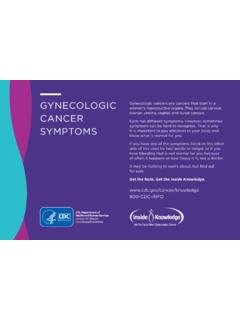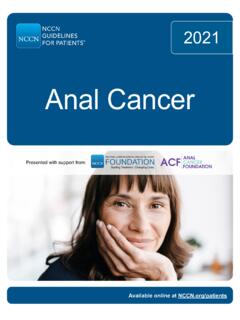Transcription of Vaginitis: Diagnosis and Treatment
1 March 1, 2018 Volume 97, Number 5 American Family Physician 321 Vaginitis is characterized by vaginal symptoms, includ-ing discharge, odor, itching , irritation, or Most women have at least one episode of vaginitis during their lives,2 making it the most common gynecologic Diagnosis in primary care. Studies have shown a negative effect on quality of life in women with vaginitis, with some women expressing anxiety, shame, and concerns about hygiene, particularly in those with recurrent most common causes of vaginitis are bacterial vaginosis, vulvovaginal candidiasis, and trichomoniasis. Bacterial vaginosis is the cause in 40% to 50% of cases in which a cause is identified, with vulvovaginal candidiasis accounting for 20% to 25% and trichomoniasis for 15% to 20% of cases.
2 Noninfectious causes, including atrophic, irritant, allergic, and inflammatory vaginitis, are less com-mon and account for 5% to 10% of vaginitis : Diagnosis and TreatmentHeather L. Paladine, MD, MEd, and Urmi A. Desai, MD, MS Columbia University Irving Medical Center, New York, New York CME This clinical content conforms to AAFP criteria for continuing medical education (CME). See CME Quiz on page 307. Author disclosure: No relevant financial affiliations. Patient information: A handout on this topic, written by the authors of this article, is available at is defined as any condition with symptoms of abnormal vaginal discharge, odor, irritation, itch-ing, or burning. The most common causes of vaginitis are bacterial vaginosis, vulvovaginal candidiasis, and trichomoniasis. Bacterial vaginosis is implicated in 40% to 50% of cases when a cause is identified, with vul-vovaginal candidiasis accounting for 20% to 25% and trichomoniasis for 15% to 20% of cases.
3 Noninfectious causes, including atrophic, irritant, allergic, and inflammatory vaginitis, are less common and account for 5% to 10% of vaginitis cases. Diagnosis is made using a combination of symptoms, physical examination findings, and office-based or laboratory testing. Bacterial vaginosis is traditionally diagnosed with Amsel criteria, although Gram stain is the diagnostic standard. Newer laboratory tests that detect Gardnerella vaginalis DNA or vaginal fluid sialidase activity have similar sensitivity and specificity to Gram stain. Bacterial vaginosis is treated with oral metronidazole, intravaginal metronidazole, or intravaginal clindamycin. The Diagnosis of vulvovaginal candidiasis is made using a combination of clinical signs and symptoms with potassium hydrox-ide microscopy; DNA probe testing is also available.
4 Culture can be helpful for the Diagnosis of complicated vulvovaginal candidiasis by identifying nonalbicans strains of Candida. Treatment of vulvovaginal candi-diasis involves oral fluconazole or topical azoles, although only topical azoles are recommended during pregnancy. The Centers for Disease Control and Prevention recommends nucleic acid amplification testing for the Diagnosis of trichomoniasis in symptomatic or high-risk women. Trichomoniasis is treated with oral metronidazole or tinidazole, and patients sex partners should be treated as well. Treatment of noninfectious vaginitis should be directed at the underlying cause. Atrophic vaginitis is treated with hormonal and nonhor-monal therapies. Inflammatory vaginitis may improve with topical clindamycin as well as steroid application.
5 (Am Fam Physician. 2018;97(5):321-329. Copyright 2018 American Academy of Family Physicians.)WHAT IS NEW ON THIS TOPICV aginitisA 2013 meta-analysis showed that oral or topical antibiotic Treatment of bacterial vaginosis in pregnancy does not pre-vent preterm birth, even in women with a history of preterm labor in previous laboratory tests such as DNA and antigen testing for bacterial vaginosis and vulvovaginal candidiasis, or vaginal fluid sialidase testing for bacterial vaginosis, may have similar or better sensitivity and specificity compared with traditional office-based testing. However, comparative cost-effective-ness has not been from the American Family Physician website at Copyright 2018 American Academy of Family Physicians. For the private, noncom-mercial use of one individual user of the website.
6 All other rights reserved. Contact for copyright questions and/or permission from the American Family Physician website at Copyright 2018 American Academy of Family Physicians. For the private, noncom-mercial use of one individual user of the website. All other rights reserved. Contact for copyright questions and/or permission American Family Physician Volume 97, Number 5 March 1, 2018 VAGINITISG eneral Diagnostic ConsiderationsHISTORY AND PHYSICAL EXAMINATIONThe history alone is unreliable for the diag-nosis of different causes of Physi-cal examination findings and office-based or laboratory test results should be used with the history to determine the Char-acteristic clinical signs and symptoms for different causes of vaginitis are listed in Ta b l e ,14,15 Risk factors for vaginitis are listed in Ta b l e ,14,16 Signs and symptoms that increase the likelihood of vulvovaginal candidiasis vs.
7 Bacterial vaginosis are a cheesy, curdy, or flocculent discharge; itching ; vulvar or vaginal inflammation or redness; and lack of A fishy odor makes candidiasis less Normal physiologic vaginal discharge is clear to white, not malodorous, not accom-panied by discomfort or pruritus, and the quantity varies during a woman s menstrual cycle. OFFICE AND LABORATORY TESTINGO ffice-based tests include microscopy, mea-surement of vaginal pH, and whiff test. A speculum is not required for collecting TABLE 1 Signs and Symptoms of VaginitisDiagnosisEtiologySymptomsSignsO ther risksBacterial vaginosisAnaerobic bacteria (Prevotella, Mobiluncus, Gardnerella vaginalis, Ureaplasma, Mycoplasma)Fishy odor; thin, homog-enous discharge that may worsen after intercourse; pelvic discomfort may be presentNo inflammation Increased risk of HIV, gonor-rhea, chlamydia, and herpes infectionsVulvovaginal candidiasisCandida albicans, can have other Candida speciesWhite, thick, cheesy, or curdy discharge; vulvar itching or burning; no odorVulvar erythema and edema TrichomoniasisTrichomonas vaginalisGreen or yellow, frothy dis-charge; foul odor; vaginal pain or sorenessInflammation.
8 Strawberry cervixIncreased risk of HIV infectionIncreased risk of preterm laborShould be screened for other sexually transmitted infectionsAtrophic vaginitisEstrogen deficiencyThin, clear discharge; vag-inal dryness; dyspareunia; itchingInflammation; thin, friable vagi-nal mucosa Irritant/allergic vaginitisContact irritation or aller-gic reactionBurning, sorenessVulvar erythema Inflammatory vaginitisPossibly autoimmunePurulent vaginal discharge, burning, dyspareuniaVaginal atrophy and inflammationAssociated with low estrogen levelsHIV = human immunodeficiency from references 10, 14, and 2 Risk Factors Contributing to VaginitisType of vaginitisRisk factorsBacterial vaginosisLow socioeconomic status, vaginal douching, smoking, new or multiple sex partners, unprotected intercourse, women who have sex with womenVulvovaginal candidiasisRecent antibiotic use, pregnancy, uncontrolled diabetes mellitus, AIDS, corticosteroid use, other immunosuppressionTrichomoniasisLow socioeconomic status, multiple sex partners.
9 Other sexually transmitted infections, unprotected intercourse, drug use, smokingAtrophic or inflammatory vaginitisMenopause, lactation, oophorectomy, radiation therapy, chemotherapy, immunologic disorders, premature ovarian failure, endocrine disorders, antiestrogen medicationsIrritant vaginitisSoaps, tampons, contraceptive devices such as condoms or diaphragms, sex toys, pessaries, topical products, douching, fastidious cleansing, medications, clothingAllergic vaginitisSperm, douching, latex condoms or diaphragms, tampons, topical products, medications, clothing, atopic historyAdapted with permission from Hainer BL, Gibson MV. Vaginitis. Am Fam Physician. 2011;83(7):809, with additional information from references 9 and 1, 2018 Volume 97, Number 5 American Family Physician 323vaginal fluid samples for these Several studies have demonstrated a strong correlation between samples from patient self-collected swabs and those collected by clini-cians for the Diagnosis of bacterial vaginosis, with sensitiv-ities of 70% to 100% and specificities of 97% to 100%.
10 18-22 It is reasonable to conclude that samples for office-based microscopy and laboratory testing for other causes of vag-initis can be collected by patients as well. Patients should be instructed to insert the swab at least one inch into the VAGINOSISA lthough Gram stain is considered the diagnostic standard, bacterial vaginosis is traditionally diagnosed using the Amsel criteria (Ta b l e 3) .14, 23 Criteria include thin, homog-enous discharge; a positive whiff test; the presence of clue cells on microscopy (Figure 114); and a vaginal pH greater than Three out of four criteria are required to make the Diagnosis , with sensitivity ranging from 70% to 97% and specificity from 90% to 94%, compared with Gram ,25 Newer methods of laboratory testing with DNA probe for Gardnerella vaginalis or detection of vaginal fluid sialidase activity have sensitivities of 92% to 100% and specificities of 92% to 98% compared with Gram culture and Papanicolaou (Pap)














